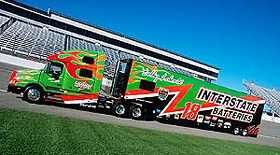Macros
Topic 3467 | Page 1
Every company has their own macros. No matter who you drive for, though, they'll give you a list of what they all are and what they're all for. It doesn't take long to get the hang of which macro to send when, and what information you need to put in which field.

See you really can talk about macros cause their all different. My arrival is mac 3. My departure call is also my empty/loaded call which is either mac 2(loaded) or Mac 5(empty). Mac 28 is hometime request. 15 is a delay call. Reason we are delayed to shipper of receiver.
Point is the reason we don't go into the Macros on the qualcomm is cause they are setup differently at each company and would be useless for anyone except those that drive for the same company.
Shipper:
The customer who is shipping the freight. This is where the driver will pick up a load and then deliver it to the receiver or consignee.
Qualcomm:
Omnitracs (a.k.a. Qualcomm) is a satellite-based messaging system with built-in GPS capabilities built by Qualcomm. It has a small computer screen and keyboard and is tied into the truck’s computer. It allows trucking companies to track where the driver is at, monitor the truck, and send and receive messages with the driver – similar to email.HOS:
Hours Of Service
HOS refers to the logbook hours of service regulations.
Every company has their own macros. No matter who you drive for, though, they'll give you a list of what they all are and what they're all for. It doesn't take long to get the hang of which macro to send when, and what information you need to put in which field.
True. Macros 18 and 19 at one company could be for pre-trip and post trip inspections for the tractor and trailer, and Macro 22 could be for maintenance issues for the same company while Macros 18, 19 and 22 at a different company could be for P.O. request for lumpers, an advance on the Comdata Card, and Delay respectively.
Dave

Thanks all. That was one thing I was wondering. If the macros were the same across the board, I see know they are not.
New Reply:
New! Check out our help videos for a better understanding of our forum features

















Preview:








 TT On Facebook
TT On Facebook
Macros - whats the deal? The last time i was on TT, several months ago, there wasnt a whole lot of info on the various macros. And the truth is, you will learn most of what you need to know during orientation, instruction and training. I say most, because depending on your trainer, you may just get the basics. Quickly, the basics are your 01 - the arrival call. 03 and 04. Departure calls from shipper and receiver, respectively. 41 and 55, pick up and drop trailer inspection reports. And the 45 daily post trip inspection. These are the most frequently used macros.
But there are other, just as important macros that you may not learn about until later. Like the macro 13. They will touch on this in orientation, but quite frankly, there is so much else going on with gaining your CDL , and Med card and other paperwork that it will be easily overlooked. It was for me, and had I not been paying attention to my settlements (paychecks), i might have lost some money over it.
Macro 13, is simply a cash PO request. Anytime you pay a toll, or get your trailer scaled, you will pay cash out of your pocket. Scales are $10 for 1st weigh, and $2 each additional re-weigh. As a company driver, I get reimbursed for these, but, i have to get a P.O. Number. Hence the Mac 13. As far as tolls go, my company provides me with an EZ pass, which is good for most tolls. There are ... 3 I think that are not covered. The Oklahoma turnpike, or Will Rogers turnpike, which is 16.50, twice and is used when going from Missouri to Texas. There is the George Bush expressway, in Texas, and I don't remember how much it is. I also don't remember he 3rd one.
The point is, in order to get reimbursed you need the Macro 13.
Another very important Macro to know is Macro 19. Directions to location. Type in either 01 or 90, and then follow the directions listed. Most times you can follow the qualcomm , but many times you cannot. It might lead you down a weight restricted road, or perhaps the shipper/receiver has changed entrances. Mac 19 will lead you the right weigh and possibly save you money. Neither my instructor nor my trainer alerted me to this fact, nor did they use the Mac 19. Thankfully I got a good dispatcher that has my back.
Mac 21 is your communication with road assist, or the mechanics in the shop. I have had issues with the mechanics in my shop, so I will say no more, except that when communicating with R/A, DO NOT use reply. Send a mac 21 every time you send a message. Don't ask me why. i don't know
Those are the most used macros, for me anyway. There are a few others for the lease operators,and few more still for the flatbedders. Me, I drive a reefer , and those are the ones I use at my company.
Im not really sure if they are the same for other companies or not, I will leave it to them to post a reply if they differ.
CDL:
Commercial Driver's License (CDL)
A CDL is required to drive any of the following vehicles:
Shipper:
The customer who is shipping the freight. This is where the driver will pick up a load and then deliver it to the receiver or consignee.
Qualcomm:
Omnitracs (a.k.a. Qualcomm) is a satellite-based messaging system with built-in GPS capabilities built by Qualcomm. It has a small computer screen and keyboard and is tied into the truck’s computer. It allows trucking companies to track where the driver is at, monitor the truck, and send and receive messages with the driver – similar to email.Dispatcher:
Dispatcher, Fleet Manager, Driver Manager
The primary person a driver communicates with at his/her company. A dispatcher can play many roles, depending on the company's structure. Dispatchers may assign freight, file requests for home time, relay messages between the driver and management, inform customer service of any delays, change appointment times, and report information to the load planners.Reefer:
A refrigerated trailer.
TWIC:
Transportation Worker Identification Credential
Truck drivers who regularly pick up from or deliver to the shipping ports will often be required to carry a TWIC card.
Your TWIC is a tamper-resistant biometric card which acts as both your identification in secure areas, as well as an indicator of you having passed the necessary security clearance. TWIC cards are valid for five years. The issuance of TWIC cards is overseen by the Transportation Security Administration and the Department of Homeland Security.
HOS:
Hours Of Service
HOS refers to the logbook hours of service regulations.